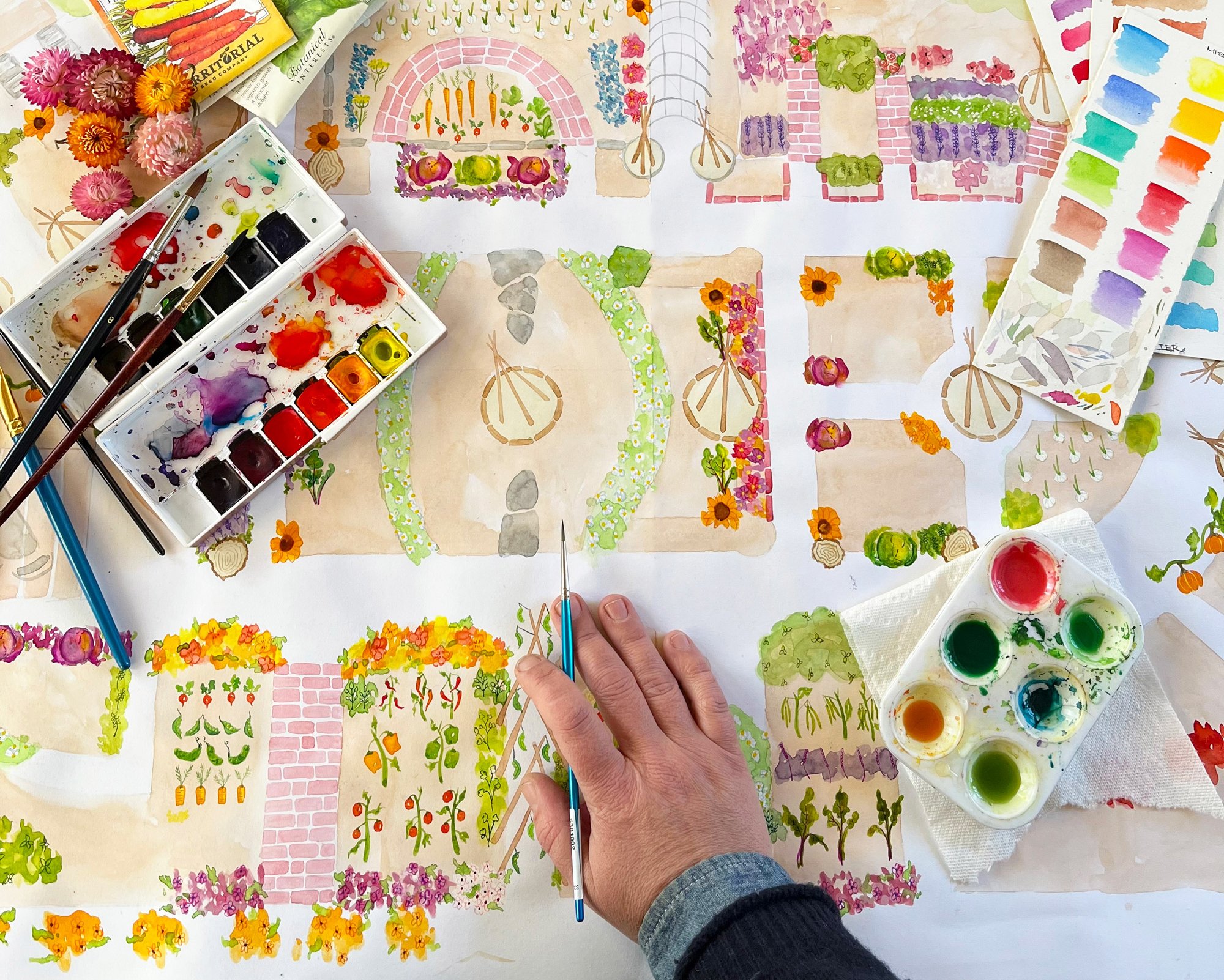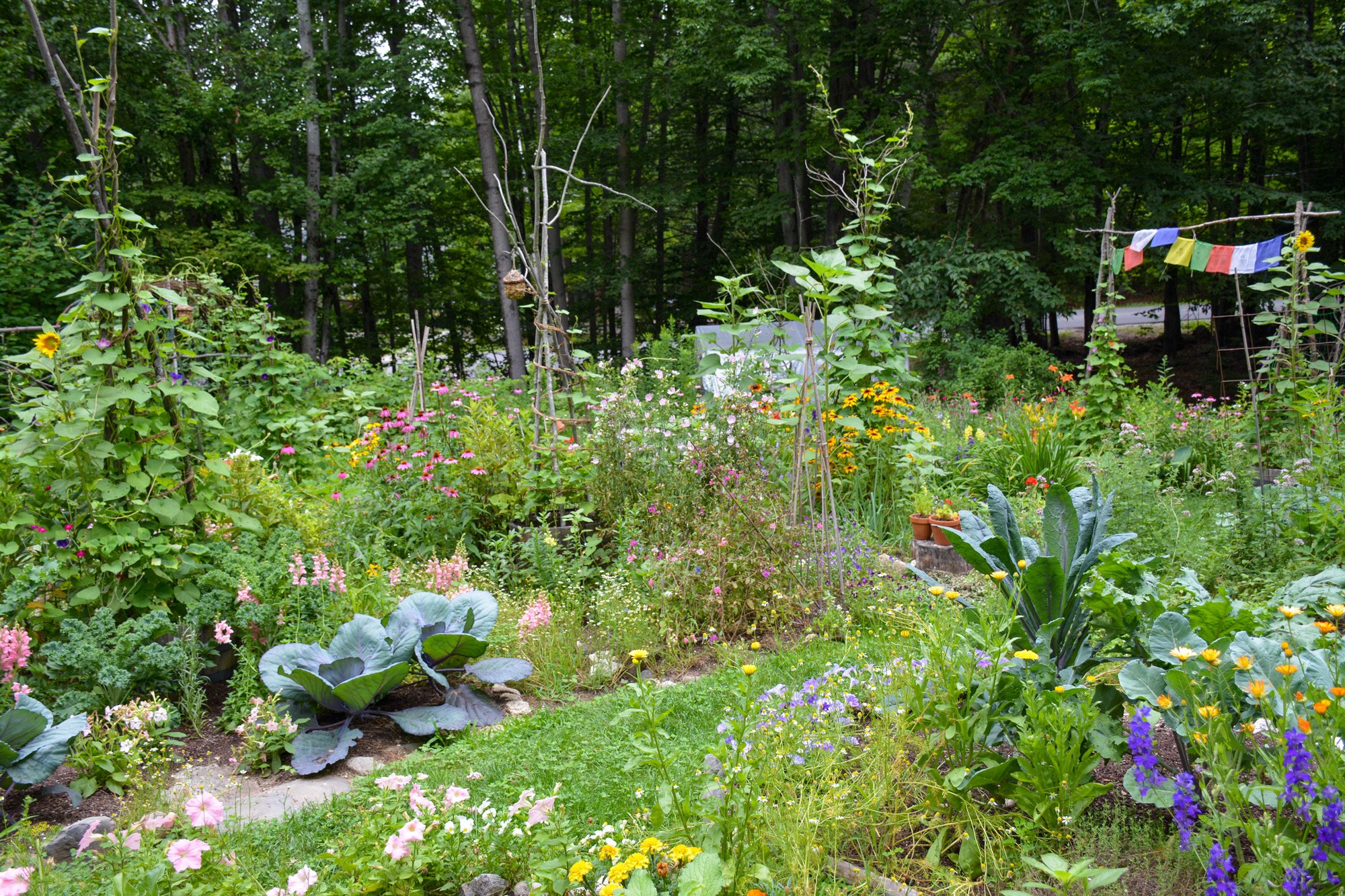• garden tips & tricks *
Planning your garden design
Kick off the growing season with the best start with a little pre-planning.
So much of gardening is really out of our control, but we can kick our growing seasons off to their best start with a little pre-planning. Our long winters give me ample time to plan, and sometimes it takes me that long to just figure out this game of garden tetris.
Before you sow that first seed, grab a piece of paper and pencil and spend some quality time thinking about your garden goals. Do you want to maximize your growing space? Are you interested in extending your season? Do you want to diversify your crops? Want to attract pollinators? A decade ago, my one goal was to grow more herbs. That one goal changed everything for me…so even though there could be a million, you only need to start with one goal and slowly build on that.
Now you have your goal, next up is to plot out your growing space. I walk my garden beds with a measuring tape and notepad, sketching up a quick layout with measurements of each bed scrawled on it. The next step is to neaten this up by drafting your layout onto a new sheet of paper. I like working big, so I actually use pasteboard, but any size works…just make sure it is large enough for you to be able to map out your crops legibly.
Alrighty, check out what you just laid out. Those are the bones of your garden. Next up, take into consideration if you plan on adding in any new beds or garden architecture like trellises and archways. Plot those out in a slightly different color on your garden plan. Using a different color will help alert you to the reality that those new elements will need to be built.
Next, map out any existing perennials, shrubs and trees.
Here’s where the garden Tetris begins…the plotting of the plants! There are some keys things to take into consideration when planning where best to plant:
• WHERE’S THE SUN? SHADE — If you don’t already know, start checking out your growing area throughout the day and make notes as to what areas are in full sun and for how long (ie. tomato patch gets 6-8 hours of full sun, where the bean area only gets 4 hours). Mark on your garden plan the areas of your garden that are shaded, partly-shaded and in full-sun. You’ll also want to make note of the solstices as how high the sun rises plays a key role as well. As an example, because I garden surrounded by woods, the sun struggles to rise about our tree line in early spring and early fall. That means much of our garden lies in shade during the months of April, May and October. Keeping a garden journal where you can jot down notes like these becomes priceless information to reference back to.
• CROP ROTATION — Pull out last year’s plan and/or garden journal and have that right beside you as your plan because you will definitely want to take crop rotation into account. Basically, if you grow the same crops in the same bed year after year, the soil will become depleted of the needed nutrients to grow those crops. Crop rotation not only helps keep your soil’s fertility healthy, it also reduces soil-borne diseases and pests that are dwelling in the dirt. Some crops are heavy feeders (lettuce, cabbage, squash, tomatoes, corn), depleting the soil of many valuable nutrients. To keep the soil balanced, follow heavy-feeding crops with ones that give back to the soil like legumes. Or follow with light-feeders like root veggies and herbs. The other key, is to remember that crop rotation applies to entire vegetable families, meaning, you can’t follow broccoli with kale or cabbage because they are all from the Brassica family. Same goes for squash and cucumbers, or tomatoes and peppers.
Companion planting with Chamomile.
• COMPANION PLANTING — The key to my organic gardening success. I was poetic about all things Companion Planting here, but it has made all the difference in my garden. Not only does it benefit each crop, it attracts pollinators (which ups pollination rates), cuts down on disease and pests and it creates the most charming display of plants. Win-win all around. Here’s a listing of some of my favorite companion plantings.
• SUCCESSION PLANTING — Though I live in a cold climate with a relatively short growing season, I can grow three-seasons if I practice succession planting. To read more about the ins and outs of success with this, please read my article here. Succession sowing also helps you achieve any goals of three-season growing.
• INTERCROPPING — This is when you plant short season varieties in the same bed as longer growing veggies, like growing lettuce with your tomatoes. The lettuce will be ready for harvest long before the tomato plants overgrow them. Radishes and carrots are another great partnership with the radishes ready for harvest long before the carrots even really start to take off. By growing these two together, the carrots benefit from the radishes keeping the soil loss, allowing for better carrot germination and root development. The Native Americans planted a combination called Three Sisters, where squash, beans and corn are planted together with the intention of the beans climbing up the corn as both grow, with the squash plants taking over below, keeping weeds down and the soil cooler.
• PLANT’S NEEDS — Is it a short plant that’s best grown in borders, or is it a tall planting of dill that begs to be in the background? Besides a plant’s height, take note of their width as well…big, bushy plants like squash may need a little extra space.
• COLOR COMBINATIONS — This is more for you flower growers out there. As you plan, dream up how the color flows throughout your garden. But it can apply to veggies too as one of my favorite views in the garden is a big bed of kale in all different hues and textures of green, purple and red. Tuck in a little companion planting of Calendula and you’ve just created a heavenly sight.
Hopefully I didn’t lose you yet, I understand this list can feel overwhelming…and it still does to me after two decades of garden planning. But taking all these needs into consideration actually is the beautiful orchestra of gardening…it truly is the culmination of your learnings being put into practice. And with each new year we learn a little more, and a little more.
When it comes to the execution of your garden planning, how you go about it is totally up to you. Find a system that works best for you. Some folks relish being able to plot it all out on the computer using planning software or their own wiley ways. I actually love using this time as an opportunity to be away from my computer and just dream in color. That’s why I choose to draw mine out in watercolors. There’s something about sloshing a paintbrush of hope across a paper on a cold, snowy day that just gives you all kinds of good feels. My collection of plans range from quick scribbles on graph paper to today’s more elaborate executions. However you choose to go about it, enjoy the process, for this is the point in gardening where it’s all pure dream with no pesky realities like pests, disease and bad weather. Soak in this exercise rather than rush it if possible. Mine lasts several weeks, with it being worked on little by little. Happy planning!
Check out SEED STARTING 101 for all sorts of good-to-grow articles on starting your season off great.
Please visit my FAVORITE VARIETIES to see what’s growing in my garden.




